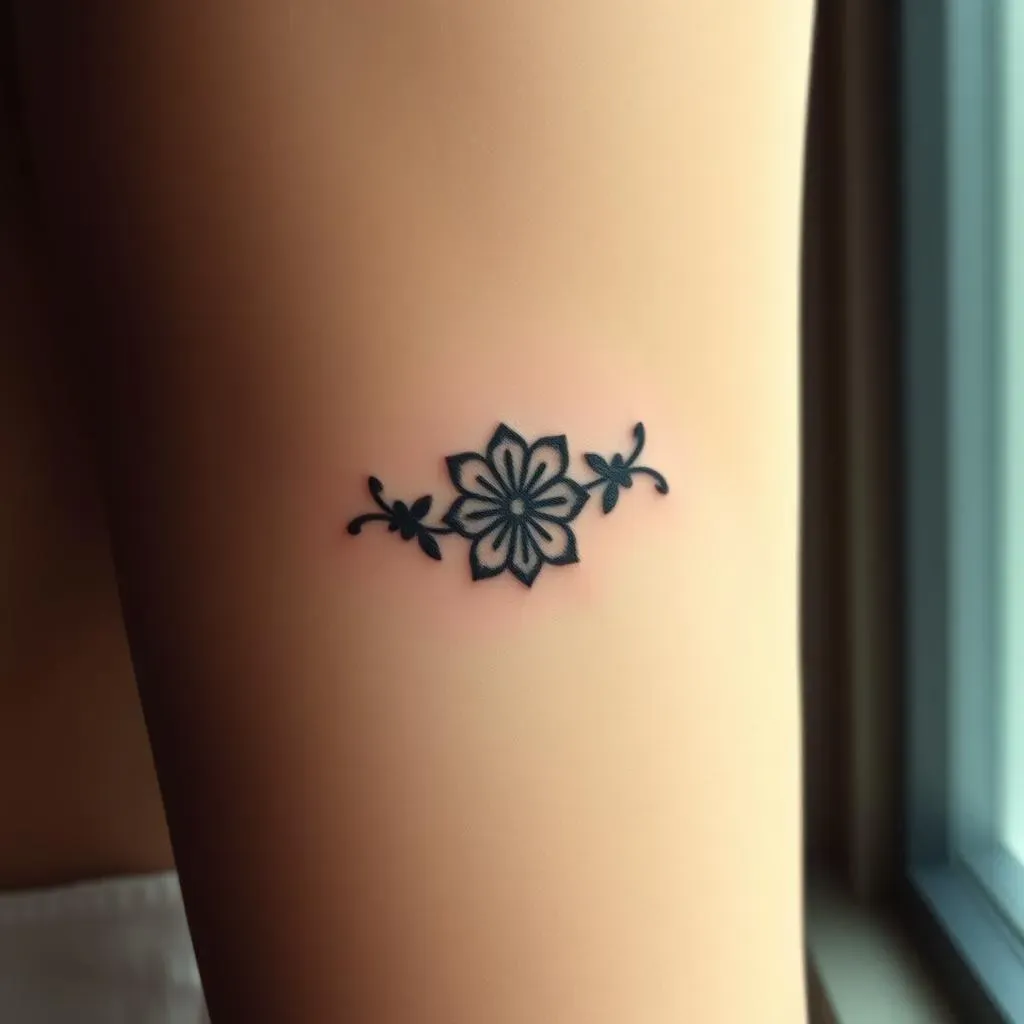Table of Contents
Ever stared at an old tattoo and thought, "What was I thinking?" You're not alone. Maybe it's a faded heart with an ex's name, a tribal design that no longer fits your style, or just a bit of regrettable ink from a wild night. Whatever the reason, if you're considering a change, you've likely stumbled into the world of cover-up tattoos. This isn't about erasing the past, but about transforming it into something you love. This article is your guide to navigating the often-tricky world of cover-ups, specifically focusing on small tattoo ideas for cover ups. We'll look at why you might choose to cover instead of remove, what design elements work best for small cover-ups, and how to find an artist who can turn your old ink into a masterpiece. So, if you're ready to say goodbye to that old tattoo and hello to something fresh and meaningful, keep reading. We’re about to explore the art of reinvention, one tiny tattoo at a time.
Why Cover Up a Tattoo? Deciding Between Removal and Redesign

Why Cover Up a Tattoo? Deciding Between Removal and Redesign
So, you're thinking about ditching some old ink? First things first, you've got a choice: laser removal or a cover-up. Laser removal sounds like something out of a sci-fi movie, and it kinda is. It blasts the tattoo ink with light, breaking it down into tiny bits that your body can flush out. Sounds easy, right? Well, it takes multiple sessions, can be pricey, and honestly, it's not always a walk in the park. Plus, some colors are stubborn and just don't want to fade. Then there's the cover-up, where you take that old tattoo and turn it into something new. It's like giving your skin a makeover, but with ink. It's a chance to get creative, to rethink what you want on your body, and sometimes it's just the more practical option. I mean, who wants to spend months with a laser when you can have a cool new design much sooner?
The decision between removal and a cover-up really comes down to a few things. How much do you hate the old tattoo? Is it dark and bold, or light and faded? What kind of new design are you dreaming of? If your old tattoo is super dark, a cover-up might be tricky because you need to go darker to hide it. If you're wanting a super light, detailed design, removal might be your only option, or at least a few sessions of laser to fade the old one first. But if you're open to a darker, bolder design, a cover-up can be a great choice. It's faster, less painful than laser, and you get a brand new tattoo out of it. Let's be real, sometimes the idea of a fresh start is just what you need, and a cover-up tattoo can be exactly that.
Factor | Laser Removal | Cover-Up Tattoo |
|---|---|---|
Time | Multiple sessions, months to years | One or two sessions, weeks |
Cost | Expensive per session | Cost of a new tattoo |
Pain | Can be painful | Similar to getting a tattoo |
Effectiveness | Not always complete removal | Can completely cover old tattoo |
Design Options | Limited, just removal | New design, creative freedom |
Small Tattoo Ideas for Cover Ups: Design Considerations

Small Tattoo Ideas for Cover Ups: Design Considerations
Thinking Small, Designing Smart
so you're going the cover-up route. Smart choice, if you ask me. But now comes the fun part: figuring out what to put on your skin. When it comes to small tattoos for cover-ups, you have to be a bit strategic. It’s not just about picking a random image, it's about working with what you already have. Think of it like this: you're not just slapping a sticker over a stain; you're creating a whole new piece of art. Darker colors are your friends here, especially if the old tattoo is dark. Blacks, blues, and deep purples can really help to conceal the old ink. Also, patterns and intricate details are great for distracting the eye. A solid block of color might not be your best bet, unless it's a really dark shade, because it can emphasize the old tattoo's shape.
Size matters too, sadly. A cover-up tattoo is almost always going to be a bit bigger than the original. Why? Because you need that extra space to hide the old lines and colors. It's like trying to cover a hole in the wall; you need a patch that's bigger than the hole itself. Don’t panic though, this doesn't mean you have to get a massive back piece. It just means you need to be realistic about the size and complexity of your design. Consider things like the shape of your old tattoo. Is it a circle? A heart? A random blob? Use that shape to guide your new design. Sometimes, you can even incorporate parts of the old tattoo into the new one, making it a very cool kind of transformation. It's all about being creative and thinking outside the box.
Design Elements That Work Wonders
Let's get into specifics, shall we? Some design elements just work better than others for covering up old ink. Floral patterns, for instance, are fantastic. The petals and leaves can be twisted and turned to hide lines and shapes. They're also super versatile and can be adapted to fit almost any area. Geometric designs are another great option. They’re bold, eye-catching, and the sharp lines can help to disguise the old tattoo's edges. Think mandalas, geometric animals, or even abstract shapes. And if you’re into something a bit more whimsical, consider using nature themes like trees, mountains, or even clouds. They offer lots of opportunities for incorporating details and shading, which are super helpful for cover-ups.
Remember, the key is to distract and camouflage. Don’t go for anything too simple or too light. Avoid open spaces and simple line drawings; they will just highlight the old tattoo underneath. Instead, go for something with lots of movement and texture. Think about the flow of the design and how it will move with your body. This will help it to look natural and not like something that's just slapped on top. You can even use negative space to your advantage, creating shapes and patterns that both conceal and enhance. The goal here is to make your old tattoo a distant memory. It is possible, trust me. Now, let's talk about finding the right artist...
Design Element | Why It Works | Things to Consider |
|---|---|---|
Floral Patterns | Versatile, hides lines and shapes | Can get busy, needs good shading |
Geometric Designs | Bold, sharp lines disguise old edges | Can look rigid, needs good placement |
Nature Themes | Lots of detail and shading opportunities | Can be complex, needs skilled artist |
Darker Colors | Conceals old ink | Need to be chosen carefully to match skin tone |
Intricate Details | Distracts the eye | Can be challenging to execute well |
Finding the Right Artist for Your Cover Up Tattoo

Finding the Right Artist for Your Cover Up Tattoo
so you've got a design in mind, now for the most important step: finding the right artist. This isn't like picking a nail salon, you know? You're trusting someone to transform a part of your body, and not every artist is up for the challenge. A cover-up tattoo is a different beast from a fresh piece on clean skin. It takes a special kind of skill and experience. You need an artist who understands color theory, can work with existing lines, and has a good eye for creating new designs that actually work with the old one, not against it. Don’t just go to the first tattoo place you see, do your homework, and make sure you're choosing someone who knows what they're doing.
Start by looking at their portfolios online. Do they have examples of cover-up tattoos they’ve done? Are the before-and-afters impressive? If you see a lot of fresh, bright tattoos but not many cover-ups, that might be a red flag. Look for artists who specialize in cover-ups or have a lot of experience with them. Pay attention to their style, too. Do you like their use of color? Their linework? Do they have a knack for the kind of design you’re going for? It's not just about technical skill but also about how well they can execute your vision. Don't be shy, reach out to them, ask questions, and maybe even schedule a consultation. It's better to take your time and find the right match than to end up with another tattoo regret.
Step | Action | Why it Matters |
|---|---|---|
1 | Review Portfolios | See if they have cover-up experience |
2 | Check Specialization | Look for artists with cover-up expertise |
3 | Assess Style | Match their style to your vision |
4 | Consultation | Ask questions, discuss your design |
5 | Read Reviews | See what others say about their work |
During a consultation, be sure to be upfront about what you're working with. Show them your old tattoo, talk about what you want to achieve, and listen to their advice. A good artist will be honest about what’s possible and what’s not, and they should be able to suggest design ideas based on your old tattoo. They'll also talk about the colors they'll use, the size of the new tattoo, and how many sessions they think it might take. It is a collaboration, after all, so you need someone you can communicate with. If an artist seems dismissive, or doesn't seem to understand what you want, it's okay to walk away. There are plenty of talented artists out there, so don't settle for less than the best.
Wrapping Up Your Tattoo Transformation
Covering up an old tattoo, especially a small one, can feel like a big decision. It's about more than just hiding something you don't like anymore; it's about reclaiming your skin and telling your story in a new way. Remember, the key to a successful cover-up lies in careful planning: consider the old tattoo's size and color, explore different design possibilities, and most importantly, find a skilled artist who gets your vision. Whether you choose something bold and intricate or a delicate and subtle design, the goal is to create a piece of art that you'll be proud to wear. So, take your time, do your research, and get ready to transform that old ink into something beautiful and uniquely you.